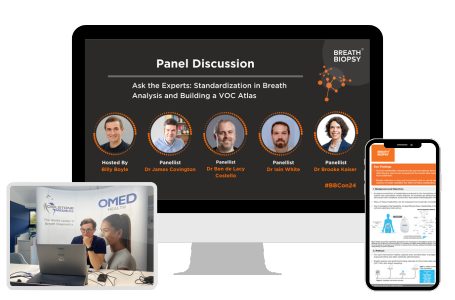Why use breath?
Exhaled breath is a promising biological matrix for biomarker analysis, but what compounds are in exhaled breath, how can you measure them, and what can these compounds indicate about disease processes happening within the body? Owlstone Medical has written an introductory blog series to cover all of these topics and more. The first in Owlstone Medical's introduction to exhaled breath analysis blog series is "Why use Breath?"
Published on: 7 Jul 2023
In the first installment of our introductory blog series, we will cover:
- The potential of breath biomarkers.
- How can breath biomarkers be used in clinical practice?
- How can breath biomarkers be used in clinical trials?
- The advantages of using breath.
The potential of breath biomarkers.
It has been estimated that we take an average of 22,000 breaths daily (1), which equals about 11,000 liters of air leaving our body. Our breath is enriched with compounds that can originate from deeper in your body and the outside air in the environment around you. Biological processes within the body produce compounds that can be transported through the circulatory system. If these compounds are volatile – meaning that they are gaseous – they can launch from the blood vessel-rich alveolar membrane in the lungs and enter the air to be consequently breathed out.
This means that every time you exhale, you breathe out thousands of compounds that have been produced all over your body. These compounds have the potential to be used as biomarkers: quantifiable compounds that can be used to measure your health and the potential presence of disease in the body.
It is routine in clinical practice to detect, measure, and analyze the changes in biomarkers in many biological samples including blood, and waste products such as urine and feces. Exhaled breath is another waste product of the body that is underutilized for the purpose of biomarker analysis but is no less enriched for potential informative chemicals.
The earliest indications that volatile chemicals in the breath could alert to disease in the body dates to ancient Greece, when Hippocrates in his treatise on breath aroma and disease attributed a distinctive breath odor to liver failure, which he referred to as fetor hepaticus. Although rudimentary, this established two important principles:
-
Exhaled breath contains compounds originating from deeper within the body than just the respiratory system.
-
Changes in the levels of these informative compounds can alert to disease states within the body.
How can breath be used in clinical practice?
Breath testing can be utilized in a very similar fashion to how blood tests are used routinely in the clinic, whereby exhaled breath is sampled and tested for the levels of a certain chemical against a reference range, and used to identify whether there are abnormal levels that indicate the presence of a disease.
A breath test already widely used in clinical practice is for a Helicobacter pylori bacterial infection in the stomach, whereby you consume a test solution containing 13 Carbon Urea (13C-Urea), and a sample of breath is collected 30 minutes after ingestion. The presence of H. pylori is indicated by ammonia and carbon dioxide in the breath sample, specifically produced by these bacteria that metabolize urea.
There are many more potentially informative biomarkers in the breath that could be used in the diagnosis, monitoring, and screening for the early detection of many other conditions including cancer, liver disease, and cardiometabolic diseases. In order to bring more breath biomarkers into clinical practice, compounds found in the breath must be validated to be associated with the disease of interest, which is work that is ongoing internally at Owlstone Medical, and in collaboration with our customers and many research partnerships.
How can breath biomarkers be used in clinical trials?
There are many different forms of biomarkers that can be used during clinical trials. For example, a breath biomarker that correlates with clinical benefit could be measured in response to the administration of a potential drug treatment. This is especially useful in cases where directly measuring clinical benefit is time-consuming, invasive, or expensive. For example, to measure the effectiveness of a drug designed to treat liver disease directly the current gold-standard is a liver biopsy to assess the extent of liver damage.
Biopsies are invasive and expensive, placing stress on patients and causing risks to health. Whereas a biomarker of liver function that could be measured in breath offers a promising, non-invasive, and cheap metric that could assess the efficacy of drug treatments.
Limonene is a volatile compound known to have a clear link to liver metabolism and health as it is typically processed by enzymes predominantly found in the liver. In a similar rationale to the 13-C Urea test, by introducing limonene as a test substance to patients, the liver’s ability to metabolize limonene, and hence the functional capacity of the enzymes within the liver can be probed to assess the presence and extent of liver disease – in an approach known as EVOC probes – and has shown the ability to accurately assess liver function (2–4).
Biomarkers that can be used in this way in clinical trials may also be used for diagnostic purposes. In the case of the EVOC probe approach using limonene in liver disease, any test that can reliably measure liver function to detect and monitor the progression of the disease or the impact of therapy is useful for clinicians, especially considering the many advantages of breath over other collecting other more invasively acquired materials such as blood, fecal matter, and tissue biopsies.
What are the advantages of using breath?
There are seven advantages of using breath over other monitoring technologies, which are explored in detail in a previous blog. The benefits are (but are not limited to):
- Breath collection is non-invasive, which has multiple benefits beyond just the improved comfort for patients and trial participants, including easier ethical approval during clinical trials, and higher uptake for widespread screening programs.
- Breath is inexhaustible, with the volume of an exhaled breath at rest being approximately 400 – 500 ml (5), and the compounds in breath samples can be pre-concentrated prior to analysis.
- Breath samples reflect metabolic activity, which can respond much faster than protein levels or genetic changes as seen in cancer. For example, the time-lag between bacteria in the gastrointestinal tract producing hydrogen, and detectable levels of hydrogen appearing in breath is five minutes or less (6).
- Breath samples allow whole-body monitoring, as it effectively samples from the bloodstream that passes through the lungs. For an average person, approximately their total blood volume circulates through their lungs every minute (7,8), meaning that a breath sample taken over a minute is enriched for compounds that have originated from the entire body.
- Breath collection provides a representative sample, which is particularly relevant when considering the alternative of tissue biopsies, which can simply miss the areas of tissue that show signs of disease.
- Breath Sampling can be undertaken anywhere, opening the possibility of decentralized trial designs and at-home breath testing for disease monitoring and diagnosis.
- Breath Sampling is comfortable, and acceptable to patients or trial participants. In an independent review, our ReCIVA device was found to be well tolerated, even in those who are suffering from acute breathlessness (9).
Now we have covered why using breath can be advantageous over other sampling mediums and is a rich source of potential biomarkers for both clinical practice and research, read the next blog in our introductory series to find out what volatile compounds can be analyzed in the breath.
Analysis of volatile compounds in exhaled breath, or those emitted from in vitro samples can an incorporated in a variety of innovative ways in your research. If you are interested in finding out how you could incorporate breath analysis in your research, please do not hesitate to contact us.
References
- Breathing | Canadian Lung Association [Internet]. [cited 2023 May 25]. Available from: https://www.lung.ca/lung-health/lung-info/breathing
- Fernández del Río R, O’Hara ME, Holt A, Pemberton P, Shah T, Whitehouse T, et al. Volatile Biomarkers in Breath Associated With Liver Cirrhosis — Comparisons of Pre- and Post-liver Transplant Breath Samples. EBioMedicine. 2015 Jul 26;2(9):1243–50. DOI: 10.1016/j.ebiom.2015.07.027
- Ferrandino G, Orf I, Smith R, Calcagno M, Thind AK, Debiram-Beecham I, et al. Breath Biopsy Assessment of Liver Disease Using an Exogenous Volatile Organic Compound—Toward Improved Detection of Liver Impairment. Clinical and Translational Gastroenterology. 2020 Sep;11(9):e00239. DOI: 10.14309/ctg.0000000000000239
- Ferrandino G, De Palo G, Murgia A, Birch O, Tawfike A, Smith R, et al. Breath Biopsy® to Identify Exhaled Volatile Organic Compounds Biomarkers for Liver Cirrhosis Detection. Journal of Clinical and Translational Hepatology. 2023 Jun 28;11(3):638–48. DOI: 10.14218/JCTH.2022.00309
- Pleil JD, Wallace MAG, Davis MD, Matty CM. The physics of human breathing: flow, timing, volume, and pressure parameters for normal, on-demand, and ventilator respiration. J Breath Res. 2021 Sep 27;15(4). DOI: 10.1088/1752-7163/ac2589
- Read NW, Al-Janabi MN, Bates TE, Holgate AM, Cann PA, Kinsman RI, et al. Interpretation of the breath hydrogen profile obtained after ingesting a solid meal containing unabsorbable carbohydrate. Gut. 1985 Aug;26(8):834–42. DOI: 10.1136/gut.26.8.834
- Ivanov KP. New Data on the Process of Circulation and Blood Oxygenation in the Lungs under Physiological Conditions. Bull Exp Biol Med. 2013 Feb 1;154(4):411–4. DOI: 10.1007/s10517-013-1963-1
- Sharma R, Sharma S. Physiology, Blood Volume. In: StatPearls [Internet]. Treasure Island (FL): StatPearls Publishing; 2023 [cited 2023 Jun 12]. Available from: http://www.ncbi.nlm.nih.gov/books/NBK526077/
- Holden KA, Ibrahim W, Salman D, Cordell R, McNally T, Patel B, Phillips R, Beardsmore C, Wilde M, Bryant L, Singapuri A. Use of the ReCIVA device in breath sampling of patients with acute breathlessness: a feasibility study. ERJ Open Research. 2020 Oct 1;6(4). DOI: 10.1183/23120541.00119-2020
Catch up on the presentations from the Breath Biopsy Conference 2024

